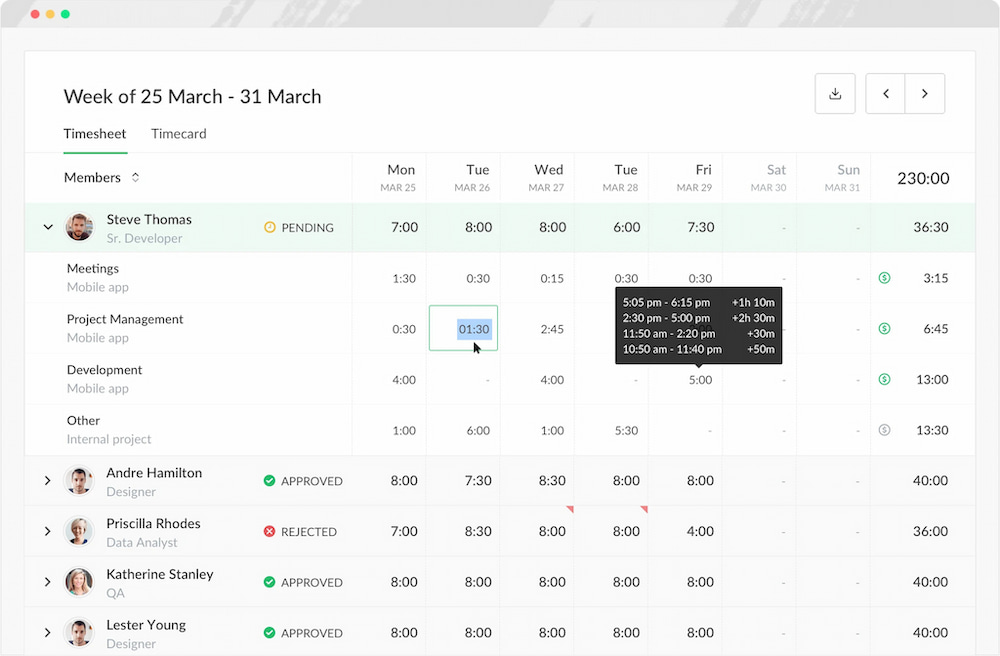For many teams—especially those moving fast, managing hybrid workers, or trying to reduce burnout—time tracking can feel like surveillance. The fear: every minute logged is another step toward micromanagement. But the truth is more nuanced. Done wrong, time tracking is a distraction. Done right, it’s a strategic asset.
Time is the most finite resource in any organization. How it’s used, wasted, or optimized can be the difference between efficient scaling and burnout. While some leaders avoid time tracking out of fear it’ll send the wrong signal, it’s often poor execution—not the tool itself—that causes resistance. Properly introducing time tracking and knowing why you use a time tracker addresses half of the issues.
This article explores when employee time tracking crosses the line into control, and how leaders can use it as a lever for trust, clarity, and better decision-making.
🔍 Why Time Tracking Feels Like Micromanagement (And Sometimes Is)
⚠️ It’s not the tracking—it’s how it’s implemented.
Time tracking gets a bad name when it’s misused—especially in industries like customer service, law, or software development where it’s tied to billing or control rather than support.
🔍 Common red flags to watch for:
- 🚫 Lack of transparency — Employees aren’t told how the data is used
- 👀 Over-monitoring — Every keystroke logged, screenshots taken
- 📉 One-sided reporting — No feedback loop, just enforcement
- ❌ Punitive usage — Logs used to discipline or terminate employees
These patterns don’t improve productivity—they break trust. People stop feeling supported and start feeling watched. Over time, that creates resentment and burnout.
💬 “The pressure to sell and the various ways that managers can monitor me creates an enormous amount of stress.” — Call center worker, as quoted by GAO’s WatchBlog
🔧 What Time Tracking Should Actually Be Used For
✅ When done right, time tracking helps everyone—not just the business. It’s not just about numbers. Time tracking use cases show that it helps teams stay balanced, focused, and fairly supported.
✨ Use it to:
- 🗂️ Improve planning: Understand where time actually goes and rebalance workloads.
- ⚖️ Prevent burnout: Spot individuals or teams working unsustainable hours.
- 📊 Refine estimates: Compare planned vs actual time to better predict future projects.
- 🙌 Support autonomy: Let employees manage and own their time logs.
- 💵 Ensure fairness: Accurately track time for hourly, freelance, and part-time workers.
🔍 Time tracking should be a mirror—not a microscope. Instead of obsessing over every second, look at the big picture:
❓ Are projects overloaded? Are teams supported? This perspective helps leaders plan better and builds a culture of trust—where employees feel empowered, not watched.
🧠 Case in point:
A midsize digital agency reduced burnout by 35% in six months. How? They analyzed time logs to flag high-load projects and reallocated work more evenly across the team. Instead of cutting hours, they fixed how they were spent.
Time tracking didn’t micromanage—they used it to improve team health. That’s the goal.
✅ How to Implement Time Tracking Without Undermining Trust
🧭 1. Start with why
Clearly explain the purpose of time tracking: workload balancing, better forecasting, or improved billing. It’s not about surveillance—it’s about solving real team pain points like burnout, delays, or lack of clarity.
📝 2. Let employees own the data
Give team members full control: allow manual logging, edits, and access to their own reports. Avoid auto-tracking unless absolutely necessary. Autonomy increases adoption.
📊 3. Focus on patterns—not individual points
Look for trends—not isolated minutes. This highlights broader problems, like underestimated tasks or inefficient meetings, rather than targeting individuals.
🤝 4. Review together—not in isolation
Use time insights during retrospectives or 1:1s. Collaborative reflection turns tracking into a growth tool—not a trap.
🧩 5. Keep it lightweight
Choose intuitive tools that integrate smoothly into existing workflows.
Tracking should be easy—not a chore.
💡 Tip:
Nominate a rotating “tracking ambassador” to gather team feedback and surface patterns. This keeps the process human and adaptive—guided by the team, for the team.
🧭 From Control to Clarity: A Comparison
| Micromanagement | Trust-based tracking | |
|---|---|---|
| Purpose | Monitor individuals | Improve team outcomes |
| Access | Hidden, top-down | Transparent and self-managed |
| Tool style | Surveillance-heavy | User-first, manual or semi-automated |
| Feedback | Rare or punitive | Embedded in coaching and retrospectives |
| Outcome | Resentment, burnout, gaming the clock | Insight, autonomy, improved planning |
This comparison shows that it’s not the tool, but the philosophy behind it, that defines the employee experience.
📌 Tools That Help (Without Overstepping)
Look for tools that:
- ✅ Allow self-logging with mobile or desktop timers
- 🔄 Integrate with your project management or calendar tools
- 💬 Support comments or notes on each entry
- 🔍 Offer manager dashboards—without exposing every detail
⭐ Why teams choose Everhour’s time tracker:
Everhour strikes the right balance between visibility and autonomy, helping teams stay aligned without feeling watched.
- ⏱️ Manual + real-time tracking: Great for both desk-based and mobile teams
- 🔗 Integrates with Trello, Asana, ClickUp, and more
- 👥 Role-based permissions: Keep logs visible only where needed
- 📊 Reports for forecasts, invoices, and resource planning

By keeping tracking flexible and transparent, Everhour turns time logs into a helpful habit—not a headache.
💬 “The trial and setup of Everhour was by far the easiest of any time tracking software. The interface is minimalist and extremely logical, so there was almost no learning curve for our team..” — Nikolay, Design Engineer
🙋 FAQ: Common Concerns Around Time Tracking
Isn’t this just another way to pressure people?
Only if you misuse the data. When used correctly, it helps reduce burnout and clarify expectations.
How do I get team buy-in?
Involve them early, explain the why, and choose a tool that puts users in control. Co-design the process to reduce resistance.
What if someone underreports their hours?
That’s a sign of culture issues—not just a tracking flaw. Use time tracking as a conversation starter, not a disciplinary measure. Encourage openness without consequences.
Can we try it without a full rollout?
Yes. Start with a pilot team or use time tracking on one client project to demonstrate value. Track adoption and feedback before scaling.
🚀 Final Thoughts: Is Time Tracking Micromanagement
Time tracking isn’t inherently bad—it’s how you frame and use it.
Key benefits of a trust-based time tracking system:
- 🔍 Transparency: Everyone knows what’s being tracked and why.
- 🤝 Autonomy: Teams control how they log their time.
- 💡 Clarity: Insights into workloads help prevent overwork.
- 📅 Planning: Data improves forecasting, resourcing, and budget alignment. Teams don’t hate visibility; they hate being controlled.
- ⚡ Efficiency: Teams spend less time guessing and more time delivering.
- 🌱 Retention: When used well, tracking can prevent overload and boost morale.
When you prioritize clarity, autonomy, and fairness, time tracking becomes a smart operational tool—not a threat.
Explore Everhour’s time tracking tools built for modern teams! Stress-free, integrated, and designed to boost clarity without compromise. Start with a free plan and see how it supports—not micromanages—your team’s best work.
Learn how time tracking can help your strategic growth and reduce your costs!

